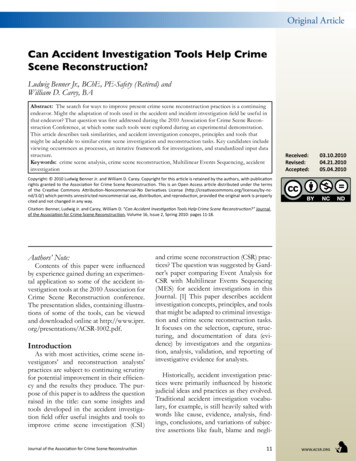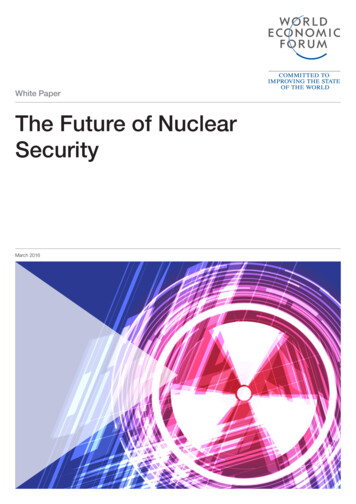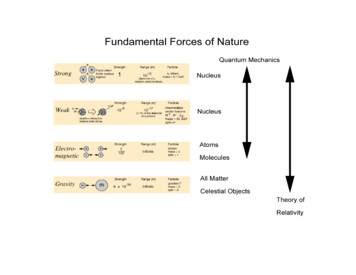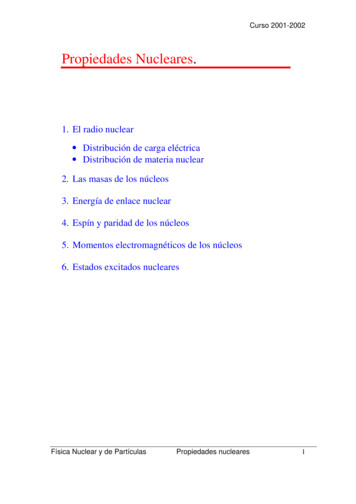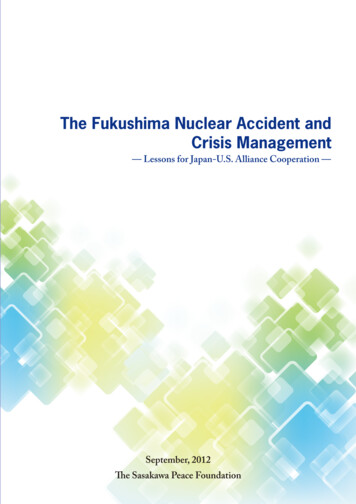
Transcription
The Fukushima Nuclear Accident andCrisis Management— Lessons for Japan-U.S. Alliance Cooperation —September, 2012The Sasakawa Peace Foundation
ForewordThis report is the culmination of a research project titled ”Assessment: Japan-US Response to theFukushima Crisis,” which the Sasakawa Peace Foundation launched in July 2011.The accident at the Fukushima Daiichi Nuclear Power Plant that resulted from the Great East JapanEarthquake of March 11, 2011, involved the dispersion and spread of radioactive materials, and thusfrom both the political and economic perspectives, the accident became not only an issue for Japan itselfbut also an issue requiring international crisis management. Because nuclear plants can become thetarget of nuclear terrorism, problems related to such facilities are directly connected to security issues.However, the policymaking of the Japanese government and Japan-US coordination in response to theFukushima crisis was not implemented smoothly.This research project was premised upon the belief that it is extremely important for the future ofthe Japan-US relationship to draw lessons from the recent crisis and use that to deepen bilateralcooperation. The objective of this project was thus to review and analyze the lessons that can be drawnfrom US and Japanese responses to the accident at the Fukushima Daiichi Nuclear Power Plant, and onthe basis of these assessments, to contribute to enhancing the Japan-US alliance’s nuclear crisismanagement capabilities, including its ability to respond to nuclear terrorism. At the same time, theproject sought to offer proposals that would contribute to enhancing the capacity of the crisismanagement system in the Asia Pacific region in the future.At the core of the project was a study group comprised of the five security and nuclear powerexperts listed below. The group met more than 10 times, and through those meetings as well as throughtrips to the United States and numerous interviews with relevant actors in the United States and Japan,they reviewed, assessed, and analyzed each country’s prior assumptions, preparations, and responses, aswell as their policymaking mechanisms.In carrying out this project, the research team received the unsparing cooperation and advice ofmany practitioners and researchers in both Japan and the United States. This was based on the sharedsincere hope that the lessons of the Great East Japan Earthquake, which took so many lives, and of thesubsequent accident at the Fukushima Daiichi Nuclear Power Plant, would not be wasted. We would liketo take this opportunity to express our deep gratitude for their kindness and cooperation. At the sametime, we would like to offer our heartfelt condolences to all those who lost loved ones, and to thosevictims who are continuing to face significant hardships as a result of the Great East Japan Earthquake.The Sasakawa Peace FoundationProject MembersNobumasa AKIYAMA, Acting Project Team Chair; Professor, Graduate School of Law,Hitotsubashi University (Introduction, Chapter 6, and Afterword)Heigo SATO, Professor, Institute of World Studies, Takushoku University (Introduction,Chapter3, and Afterword)Kaoru NAITO, President, Nuclear Material Control Center (Chapter 4)Yosuke NAOI, Deputy Director, Integrated Support Center for Nuclear Nonproliferationand Nuclear Security, Japan Atomic Energy Agency (Chapter 5)Tadahiro KATSUTA, Associate Professor, School of Law, Meiji University (Chapter 1 and 2)Project Team AssistantNote: This project was a self-initiated research project conducted by the Sasakawa Peace Foundation’sHarumi ARAI, PhD Candidate, Takushoku UniversityJapan-US Exchange Program. The contents of this report, however, are the opinion of the study groupmembers and do not reflect the opinions of the Sasakawa Peace Foundation, nor do they reflect theopinions of the experts who kindly participated in interviews or meetings during the course of the project.
Table of ContentsForeword . 1Introduction . 5Chapter 1: The Accident at the Fukushima Daiichi Nuclear Power Plant .91.1 An overview of the accident at the Fukushima Daiichi Nuclear Power Plant .9(1) Earthquake and tsunami .9(2) Timeline of the accident . 11(3) The spent fuel pool and other conditions at the plant, and the exposure of workers to radiation. 151.2 The government response and evacuation of residents: offsite conditions . 18(1) Government response . 18(2) Evacuation of residents/evacuation zone . 211.3 The inadequacies of the response to the accident. 24(1) Were accident prevention measures sufficient? . 24(2) Were accident mitigation efforts sufficient? . 26Chapter 2: The Societal Impact of the Nuclear Accident . 292.1 Response to the contamination problem . 29(1) Contamination of food and water . 29(2) Government policy on human radiation exposure . 30(3) Decontamination efforts . 31(4) Impact on industry and others . 322.2 Impact on nuclear energy policy . 33(1) Impact on power supply stability . 33(2) Distrust of past nuclear energy administration and changes in nuclear energy policy . 34(3) Impact on nuclear energy policy abroad . 362.3 Societal impact and issues in the wake of the disaster . 38(1) Social impact of the radioactivity . 38(2) Social impact caused by the lack of clear information . 40(3) Compensation issue . 42Chapter 3: Japan-US Cooperation and Crisis Management after th eFukushima Daiichi Nuclear Power Plant Accident . 463.1 The Fukushima nuclear accident and Japan-US cooperation . 463.2 A chronology of Japan-US cooperation and crisis management . 493.3 Military-to-military cooperation . 523.4 Differences in American and Japanese approaches to crisis management and the role ofthe Bilateral Joint Operations Coordination Center . 533.5 Overall evaluation of Japan-US cooperation . 56(1) Information . 57(2) Channels of Dialogue. 58(3) Issues on the US side . 59(4) The transition from normalcy to emergency conditions. 603.6 Japan-US defense cooperation and nuclear safety . 61Chapter 4: Vulnerabilities in Nuclear Security . 634.1 The international background of expanding and strengthening nuclear security policy . 634.2 International and domestic responses to strengthening nuclear security measures . 65(1) International responses. 65(2) Domestic responses . 692
4.3 Japan’s response to the nuclear security lessons learned from the Fukushima accident . 73(1) Report of the Japanese Government to the IAEA Ministerial Conference on Nuclear Safety . 73(2) Deliberations and report of the Advisory Committee on Nuclear Security (Sept. 2011) . 74(3) Deliberations and report of the Advisory Committee on Nuclear Security (March 2012) . 75(4) Actions taken by regulatory and other bodies in response to the report of the AdvisoryCommittee on Nuclear Security. 774.4 Threat perceptions in the United States and Japan prior to and after the Fukushimaaccident . 78Chapter 5: Strengthening Japan-US Cooperation in the Nuclear Security Field . 815.1 The history of Japan-US cooperation in the nuclear security field . 815.2 Strengthening Japan-US cooperation . 83(1) Human resource development. 83(2) Japan-US joint outreach efforts . 85(3) Development of technology for measuring and detecting nuclear material . 865.3 Applying the lessons learned from the Fukushima Daiichi Nuclear Plant accident in JapanUS cooperation . 92(1) Preparation for mitigation. 92(2) Insider threat countermeasures. 92(3) Research on the synergy between nuclear safety and nuclear security . 93(4) Implementation of INFCIRC/225/Revision 5 . 93(5) Strengthening nuclear security in the transport sector . 93(6) Measures for decommissioning the Fukushima Daiichi Nuclear Power Plant . 94Chapter 6: Lessons and Recommendations: Improving Crisis Management and ResponseCapability—Capacity Building for Japan and the Japan-US Alliance . 956.1 Decision-making and crisis-response mechanisms . 95 Lessons . 98 Recommendations . 1016.2 The role of information in effective decision making . 105 Lessons . 106 Recommendations . 1076.3 The role of Japan-US joint action frameworks: the barrier of a vertically divided system ofJapan-US counterparts . 109 Lessons . 110 Recommendations . 1126.4 Efforts by the United States and Japan (the alliance) toward the international community. 115 Recommendations . 116Afterword . 120Appendix 1: Timeline of the accident at the Fukushima Daiichi Nuclear Plant (Units 1–4) . 125Appendix 2: What is nuclear power generation? . 128Appendix 3: What are radioactive contamination and radiation exposure? . 129Appendix 4: About the project members . 1333
Frequently Used AbbreviationsBWRboiling water reactorCTBTOComprehensive Test Ban Treaty OrganizationDPJDemocratic Party of JapanERCEmergency Response Center (METI)IAEAInternational Atomic Energy AgencyICisolation condenserJAEAJapan Atomic Energy AgencyINESInternational Nuclear and Radiological Event ScaleMAFFMinistry of Agriculture, Forestry and FisheriesMETIMinistry of Economy, Trade and IndustryMEXTMinistry of Education, Culture, Sports, Science & TechnologyMHLWMinistry of Health, Labour and WelfareMOFAMinistry of Foreign AffairsNGSINext Generation Safeguards InitiativeNISANuclear and Industrial Safety AgencyNRC(US) Nuclear Regulatory CommissionNSC(Japan) Nuclear Safety CommissionNSWGJapan-US Nuclear Security Working GroupRCICreactor core isolation cooling systemSDFSelf-Defense ForcesSPEEDISystem for Prediction of Environmental Emergency Dose InformationTEPCOTokyo Electric Power CompanyWINSWorld Institute for Nuclear Security4
IntroductionThe immediate cause of the March 2011 accident at the Fukushima nuclear power plant was themelting of the reactor cores and the hydrogen explosions that occurred after the tsunami knocked outall of the plant’s electrical supply. In response to this major accident, all relevant actors including theTokyo Electric Power Co. (TEPCO) and the government authorities have devoted their full energiesto cooling the nuclear reactor, receiving cooperation from the United States and France in the process,and currently the situation is calming down. However, there is still a great deal to be done before thereactors can be decommissioned, and with many obstacles still to overcome, the outcome remainsunpredictable.Nuclear power generation is a system in which electricity is generated using the enormous energycreated through the nuclear fission of uranium fuel. The enormous energy from nuclear fission wasfirst utilized practically for the atomic bombs in 1945. Then, technology was first used for generatingelectricity in 1951 in an experimental breeder reactor (EBR-1). The world’s first functioning nuclearpower plant was the Obninsk power plant, which began operating in 1954 in what was then the SovietUnion.Subsequently, nuclear power plants were commissioned in England in 1956 and in the United Statesin 1957. In Japan, the first commercial nuclear reactor went online in 1966 at the Tokai Power Station.In part influenced by the first oil crisis that struck the international community in 1974, theintroduction of nuclear power proceeded at a rapid pace from the mid-1970s, as industrialized nationsbecame increasingly concerned about the instability of fossil fuel supplies, but from the mid-1980s on,the growth of nuclear energy seemed to stagnate. Recently, however, with the rapid economic growthin newly emerging nations, there has been a noticeable upturn in the construction of nuclear powerplants.During this time, there have been three major accidents at nuclear power plants worldwide. The firstoccurred in the United States in March 1979 at the Three Mile Island nuclear power plant. Theincident occurred when the reactor’s main feedwater pumps, valves, and other equipment failed, andthe operators mistakenly shut down the emergency core cooling device. That led to a loss of water inthe core container, thereby damaging the fuel. However, because the plant’s system for containing therelease of radioactive materials was operational, only a minimal amount of radioactivity was releasedand there was no significant impact on the surrounding region. The proximate cause of this accidentwas said to be the operators’ lack of knowledge, training, and regulations, and after reflecting deeplyon this incident, the United States implemented broad-ranging reforms.The second accident was Chernobyl. It occurred in April 1986, at a time when the reactor had beenshut down and a test was being implemented to determine whether backup generators would beoperational in the case of an external power failure. The plant was operating at low power levels overan extended period of time, which was prohibited, and when the tests began, almost all of the controlrods had been extracted. They then attempted to reinsert the control rods all at once (probably becausethe power output spiked), which resulted in a nuclear burst that ignited the graphite moderator,melting the core and dispersing radioactive materials. Because there was no containment vessel forthis reactor (Unit 4), the radioactive materials were not contained in this case and were released intothe surrounding area. This was a major accident that affected not only Russia but the broaderEuropean region. Although design flaws also played a role, here again the proximate cause was afundamental deficiency among the reactor operators in terms of knowledge, regulations, training, andother factors, and in that sense this accident was also a man-made disaster.1The third accident was the Fukushima nuclear plant accident that occurred in March 2011. In this case,the proximate cause was the power failure at the reactor caused by a natural disaster—the earthquake.The reactor was designed with a positive void coefficient (i.e., if boiling occurs for some reason, the poweroutput rises dramatically, which further accelerates boiling, thereby accelerating the output—or in other words,it creates a vicious cycle and leading to a power burst), which is prohibited in Western reactors.15
and tsunami—and thus it was fundamentally different in nature than the accidents at Three MileIsland in the United States or at Chernobyl in Russia, which were caused by errors committed by theoperating personnel. However, the Fukushima Nuclear Accident Independent InvestigationCommission (The National Diet of Japan) determined that “despite numerous opportunities to comeup with countermeasures, successive generations of regulatory authorities and TEPCO’s managementresorted to delay tactics.” The commission therefore concluded that the accident “cannot be regardedas a natural disaster. It was a profoundly manmade disaster.”In other words, the indirect causes of the Fukushima accident can be assumed to be an accumulationof offsite mismanagement in terms of disaster prevention and mitigation. However, the relationship interms of the accident’s cause and effect has yet to be determined, and many of the wide-ranging issuesthat the accident raised both within Japan and abroad will require greater efforts to resolve. Detailedanalysis and study is required on the indirect causes of this accident to determine where precisely thedeficiencies in crisis management reside.Needless to say, the accident at the Fukushima Daiichi power plant has raised serious questions notonly for Japan but for the entire international community about safety management at nuclear powerplants and about nuclear security. In Japan, it has had a major impact on industry and energy, but alsoon Japan’s society and lifestyle as the people have been forced to change their fundamentalconception of safety management for nuclear power. The issues are far-reaching and many have yet tobe resolved, but the key issues include (1) the response to nuclear accidents and safety management;(2) the revision of energy policy; (3) the handling of radioactive contamination and reparation issues;(4) concerns related to electrical power production and supply (PPS); (5) the restructuring of nuclearpower safety management (the launch of a new Nuclear Regulation Authority and nuclear regulationagency in September 2012); (6) onsite nuclear power safety measures, and the strengthening ofnuclear security; (7) the question of maintaining nuclear power–related technology and personnel andthe question of nuclear exports; and so on. Each of these issues in turn contains many subsidiary orrelated issues, but we will avoid going into detail here.Most of these issues need to be resolved first within Japan, but international cooperation will berequired on many issues as well. Naturally, however, in order for Japan to pursue internationalcooperation, it must first show that it has sufficient nuclear safety management and crisis managementsystems in place to lead other countries. It is unlikely that it will be able to win the trust of othercountries if it attempts to undertake international cooperation without first taking these steps. In otherwords, if Japan is going to maintain its nuclear power program, then it will need to take drasticmeasures to shore up its safety management.Of course, ensuring the safety of nuclear power requires that safety management at nuclear plants becombined with nuclear security measures. Nuclear security refers to comprehensive measures toensure the safety of nuclear-power facilities and nuclear materials against illegal or malicious acts.The Fukushima accident was of course not a nuclear security–related accident. It was not a terroristattack on the nuclear plant nor an accident that occurred as a result of the theft of nuclear materials.However, there were certain factors behind the accident at Fukushima that might have been preventedhad greater consideration been paid to nuclear security in advance. The accident has also created anew problem by exposing a vulnerability—i.e., that major disasters can be caused by power failuresnot only at the reactors themselves, but also at the surrounding critical facilities. It is thus clear thatJapan must pursue a combination of measures to ensure both nuclear security and nuclear powersafety management. Since the accident, the Japanese government has been strengthening its initiativesto enhance nuclear security. The current status of such initiatives should be outlined and more indepth discussions should also be held on their future direction.Meanwhile, as of January 2012 there were 427 nuclear reactors in operation in about 30 countriesaround the world, as well as 169 reactors that are either under construction or in the planning stages.2Of those, a total of 111 are in Asia: 50 in Japan (not including Units 1–4 at Fukushima Daiichi), 21 in2. “Generating Capacity of Nuclear Power Plants in the World,” Japan Atomic Industrial Forum website,http://www.jaif.or.jp/ja/nuclear world/overseas/f0103.html.6
South Korea, 20 in India, 14 in China, and 6 in Taiwan. There are also plans for new construction inthe region, as China plans to build additional 48–80 reactors by 2020, South Korea will add 3–6, andIndia is planning on building 20–26. Vietnam is planning on introducing nuclear power plants as well,with 13 reactors scheduled to be constructed by 2030. As a result, the number of nuclear power plantsin Asia is expected to nearly triple by the year 2035.The reason that the number of countries wanting to adopt nuclear power is so high despite the risks ofa nuclear accident is that nuclear power enables countries to gain an enormous supply of electricityfrom a small quantity of uranium fuel. The advantage of possessing a high-density energy with a verylarge effect in terms of fuel reserves is becoming attractive to countries that are seeking economicgrowth and economic development. It also has a number of other advantages: the suppliers of naturaluranium (the raw material needed for nuclear power) are politically stable countries such as Australiaand Canada, making it a highly stable fuel supply; the low level of CO2 emissions is good for theenvironment; and the price is relatively low compared to other sources of energy. Emerging nationsare thus becoming increasingly interested in adopting nuclear power not only for economic reasons,but also from the perspective of energy security and environmental protection.However, nuclear power also brings problems such as the risk of nuclear accidents and the treatmentand disposal of radioactive waste, and it entails many issues on both the safety management andsecurity fronts.Many problems exist, above all the fact that some developing countries that already possess nuclearpower plants do not have a sufficient level of technology or nuclear-related engineers to meet therequirements of their planned new construction and expansion of nuclear power plants, the personneland responsibilities for operations management and crisis management are unclear, and it is possiblethat they will be reluctant to share information or accept assistance from other countries when anaccident does occur.In any event, the crises that one can foresee occurring in the future in the operation of nuclear powerplants include the loss of power or cooling systems (including by subversive acts), illegal actions inthe administration of nuclear facilities and nuclear materials or illegal actions against the means oftransport of nuclear materials (disruption, illegal photographs, etc.), failures in crisis management(including the protection system), information sharing, and mistakes or internal threats in terms ofinformation manipulation. Those countries that possess nuclear power capabilities have an enormousresponsibility to address these problems. Serious consideration must be given to ensure that thesetypes of accidents never happen again in Japan or in the international community. The InternationalAtomic Energy Agency (IAEA) is making various efforts to that end, South Korea hosted a nuclearsecurity summit in March 2012, and the Japanese government will hold an international conference atthe end of this year on nuclear safety management, all of which contribute to the necessary efforts.Looking back on the handling of the accident at the Fukushima nuclear power plant, the close way inwhich the United States and Japan cooperated is striking, and it is no exaggeration to say that it wasthanks to the Japan-US alliance that the damage caused by the Fukushima accident was kept to aminimum. The close exchange of information and mutual cooperation between the two countriesproduced many lessons, and one could say that it has created a foundation for future Japan-UScooperation on issues related to nuclear safety management and nuclear security.Over the past half-century, the Japan-US alliance has consistently contributed to the peace andstability not only of the United States and Japan, but also of the Asia Pacific region as a whole. Thisalliance relationship extends beyond the fields of security, diplomacy, and defense, to such fields aseconomics and finance, and the trustworthiness of the alliance has enabled the relationship to developthrough mutual effort to a point where we can pursue cooperation in crisis management and responseas the most trusted of allies. In the handling of the Fukushima incident as well, although there weresome mutual misunderstandings seen in the initial management of information, in the end Japan-UScooperation produced results and the issues were resolved.This project examined and analyzed the American and Japanese responses to the Fukushima nuclearplant accident and the lessons to be drawn from those experiences. The objective was to draw onthose lessons to help strengthen the capacity of the Japan-US alliance to deal with nuclear crises,7
including nuclear safety management and nuclear terrorism, and improve the capacity of the world’snuclear management and crisis management systems.In particular, with respect to the accident at Fukushi
power plant was the Obninsk power plant, which began operating in 1954 in what was then the Soviet Union. Subsequently, nuclear power plants were commissioned in England in 1956 and in the United States in 1957. In Japan, the first commercial nuclear reactor went online in 1966 at the Tokai Power Station.



